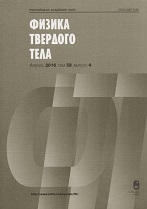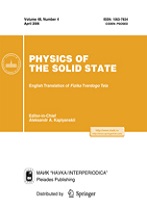|
Ferroelectricity
Dielectric response of ceramic 16BiScO$_{3}$–42PbMg$_{1/3}$Nb$_{2/3}$O$_{3}$–42PbTiO$_{3}$ solid solutions in an electrical field
L. S. Kamzinaa, M. V. Talanovb, A. A. Bushc, A. I. Spitsinc
a Ioffe Institute, St. Petersburg
b Research Institute of Physics, Southern Federal University
c MIREA — Russian Technological University, Moscow
Abstract:
Some results of studying the dielectric and electromechanical properties of ceramic 16BiScO$_{3}$–42PbMg$_{1/3}$Nb$_{2/3}$O$_{3}$–42PbTiO$_{3}$ relaxor ferroelectric samples in electrical fields (0 $<E<$ 20 kV/cm) are presented. An appreciable decrease in the dielectric permittivity with time, and the disappearance of hysteresis in the dependence of the longitudinal strain on the electrical field intensity were revealed in the fields exceeding the coercive field ($E>$ 10 kV/cm) and explained by the induced ferroelectric phase transition. The field-induced phase (presumably, tetragonal) was shown to be unstable and partially ordered. A nonmonotonical character demonstrated by the dielectric permittivity–time dependences of the studied ceramics unlike the other relaxor ferroelectrics was explained by the coexistence of glassy and ferroelectric phases.
Keywords:
ferroelectricity, relaxors, phase transitions.
Received: 01.04.2019
Revised: 01.04.2019
Accepted: 02.04.2019
Citation:
L. S. Kamzina, M. V. Talanov, A. A. Bush, A. I. Spitsin, “Dielectric response of ceramic 16BiScO$_{3}$–42PbMg$_{1/3}$Nb$_{2/3}$O$_{3}$–42PbTiO$_{3}$ solid solutions in an electrical field”, Fizika Tverdogo Tela, 61:8 (2019), 1483–1487; Phys. Solid State, 61:8 (2019), 1428–1432
Linking options:
https://www.mathnet.ru/eng/ftt8729 https://www.mathnet.ru/eng/ftt/v61/i8/p1483
|


| Statistics & downloads: |
| Abstract page: | 56 | | Full-text PDF : | 15 |
|





 Contact us:
Contact us: Terms of Use
Terms of Use
 Registration to the website
Registration to the website Logotypes
Logotypes









 Citation in format
Citation in format 